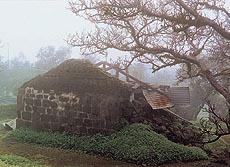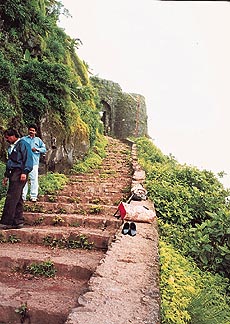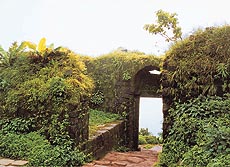










 








 

 |
More than a
lesson in history
Kondane
Fort, with its mediaeval foundation, fell to Muhammad Bin
Tughlak in 1328, and to succeeding invaders of the Deccan
such as Malik Ahmad of Ahmadnagar in 1486, and to the
Bijapur monarchs in 1637. After Shivaji’s most
trusted general Tanaji captured the fort for the Marathas
in 1647, it was coveted by the Mughals who even blockaded
it in 1701 for two years. It was not till 1818, that the
British managed to free the fort, and Sinhgarh became a
hill resort, says Shona Adhikari
WE headed out early in the morning
to Shivaji’s fortress Sinhgarh, lying 25 km from
Pune, and situated beyond Kharakvasla lake that is the
city’s main supply of water. In the monsoon, the
enormous lake fills up to the brim, while beyond on the
other bank, can be seen the National Defence Academy, the
country’s premier institution for defence studies.
 As we neared Sinhgarh, the weather seemed
appreciably cooler. It was around 7.30 in the morning,
and despite the fact that the sun was already up, seen
from the base of the steep rise, the fort situated 2.300
ft up, was shrouded in mist. The drive up the steep hill
was taken in second gear, and the road was almost
deserted. A few enterprising student groups were walking
up no doubt playing hookey from college! As we neared Sinhgarh, the weather seemed
appreciably cooler. It was around 7.30 in the morning,
and despite the fact that the sun was already up, seen
from the base of the steep rise, the fort situated 2.300
ft up, was shrouded in mist. The drive up the steep hill
was taken in second gear, and the road was almost
deserted. A few enterprising student groups were walking
up no doubt playing hookey from college!
We reached the parking
lot, from where there was no other way up, except on
foot. Some tourist buses had reached before us, and large
handis of food were being unloaded. Sinhgarh fort
with its hill-station weather is a popular picnic spot.
Visitors are allowed to picnic in the area, but are
expected to clean up before they leave. The park also
employs a large staff to clean and maintain the natural
vegetation, and the houses built during the British rule.
Seen from below, the
huge rock on which Sinhgarh is built, rises up like a
spectre in the mist. The path opens to steep steps
leading up to the upper reaches, and passing through a
number of stone arches. There were four formidable entry
points at one time, each with three separate gates. These
gates are now in ruins and overgrown with moss. Named
after the cities they face, the Pune Gates are the first
set of triple gateways that visitors encounter on their
way up. The ‘Kalyan’ and ‘Raigarh’
gateways, still more or less intact, must have been
impressive in Shivaji’s time.
 Since besiegers to the fort had
to drag their guns up the hills, Sinhgarh was safe from
attackers, till Shivaji’s most trusted general,
Tanaji Malsure, led his soldiers up in the dead of night.
He achieved this almost impossible task, by innovatively
training giant lizards (known as ‘Ghorpuds’
in local parlance), to climb up with rope ladders tied to
their backs. The Ghorpuds scaled and clung fast to
the rock face, allowing Tanaji’s soldiers to reach
the summit. Since besiegers to the fort had
to drag their guns up the hills, Sinhgarh was safe from
attackers, till Shivaji’s most trusted general,
Tanaji Malsure, led his soldiers up in the dead of night.
He achieved this almost impossible task, by innovatively
training giant lizards (known as ‘Ghorpuds’
in local parlance), to climb up with rope ladders tied to
their backs. The Ghorpuds scaled and clung fast to
the rock face, allowing Tanaji’s soldiers to reach
the summit.
Tanaji, having managed
to wrest Kondane Fort from the Bijapur monarchs, did not
live to celebrate the victory, and died in action.
Shivaji, when told of general’s death, is reputed to
have said; "We have won the fort but lost the
lion." He renamed the fort in 1647, calling it
Sinhgarh, or ‘fortress of the lion’. A memorial
marks the spot where Tanaji breathed his last. The
samadhi, rather like a small temple, appears to have been
built in 1941. In the style of the region the structure
is painted an auspicious vermillion, but, fortunately,
the beautifully carved stone bust has been left in its
natural state.
Kondane Fort with its
mediaeval foundation, fell to Muhammad Bin Tughlak in
1328, and to succeeding invaders of the Deccan such as
Malik Ahmad of Ahmadnagar in 1486, and to the Bijapur
monarchs in 1637. After Tanaji captured the fort for the
Marathas in 1647, it was coveted by the Mughals who even
blockaded it in 1701 for two years.
It was not till 1818,
that the British managed to free the fort, and Sinhgarh
became a hill resort, popular for day outings.
Balgangadhar Tilak built a cottage within the fort, and
would take time off from his busy schedule to spend a few
days there. The cottage is now a rest house, and while
the inner furnishings have been changed, the exterior is
probably much as it was during Tilak’s time.
An interesting place to
visit is the ‘Gunpowder Store’, a small stone
structure, with a sloping roof. Even more interesting is
the cave dug out of sheer rock, which was used as a
stable for horses, where they could be safely hidden from
sight, and be protected from the vagaries of nature. A
natural spring that provided water for the horses
throughout the year can still be seen.
 A broken down temple, dedicated to Shiv-
Parvati, is located next to a small natural lake. An
attempt to cover the roof with corrugated tin sheets on a
wooden frame, met with little success, and a gale that
hit the area about a year ago, brought the roof down
again. However, dilapidated or otherwise, the temple
continues to receive homage from the dozen or so families
who live at the fort. The brass bell hanging above the
shrine wears a polished look from frequent use, and there
is fresh vermillion on the foorheads of the deities.
Those who live in the fort are all descendants of
Shivaji’s trusted aides and continue to be
responsible for its upkeep. A broken down temple, dedicated to Shiv-
Parvati, is located next to a small natural lake. An
attempt to cover the roof with corrugated tin sheets on a
wooden frame, met with little success, and a gale that
hit the area about a year ago, brought the roof down
again. However, dilapidated or otherwise, the temple
continues to receive homage from the dozen or so families
who live at the fort. The brass bell hanging above the
shrine wears a polished look from frequent use, and there
is fresh vermillion on the foorheads of the deities.
Those who live in the fort are all descendants of
Shivaji’s trusted aides and continue to be
responsible for its upkeep.
The high altitude with
its accompanying climate makes it ideal for flora and
fauna to flourish. In the monsoon the grass underfoot is
covered with tiny pink flowers, while moss clings to the
branches of the trees. Wild balsam in purples and pinks
growing in clusters are interspersed with tiny yellow
daisies. Huge banana trees grow on the hillside, and
according to the caretakers, have grown there since
Shivaji’s time, a new one appearing when the old
tree dies.
A number of tea stalls
beckon visitors to taste their speciality, ‘vada
pao’, one of the region’s most famous snacks,
it consists of slices of bread accompanied by pakoras.
In that misty atmosphere, holding a cup of hot tea, and
the excellent ‘vada pao’ filling the void
brought on by the strenuous climb, the visit to Simhagarh
becomes more than a lesson in history. Sitting up there
one may well ponder on how times have changed, and about
the larger than life character of Shivaji.
|

